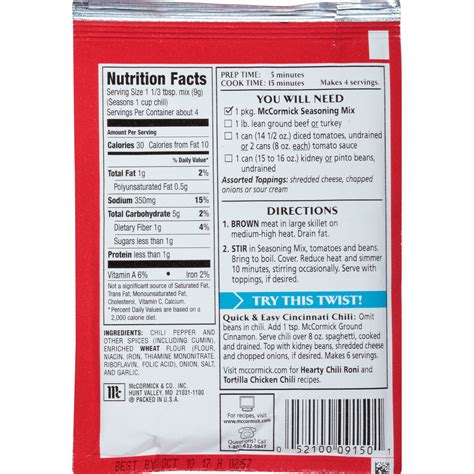McCormick Chili Seasoning Recipe: A Flavor Explosion for Your Chili
McCormick chili seasoning is a staple in many kitchens, providing a quick and easy way to add a depth of flavor to your chili. But have you ever wondered how to really elevate your chili game using this versatile blend? This blog post will explore various McCormick chili seasoning recipes, offering tips and tricks to create a chili that's not just delicious, but also optimized for search engines. We'll cover different chili variations, explore substitutions, and provide some SEO best practices to help you share your chili creations online.
Understanding McCormick Chili Seasoning
Before diving into recipes, let's understand the foundation: McCormick chili seasoning. This blend typically contains a mix of chili powder, cumin, paprika, garlic powder, onion powder, oregano, and cayenne pepper. The exact proportions vary, leading to slight differences in flavor profiles between batches. This inherent variability is what makes experimenting with McCormick chili seasoning so exciting!
The Power of Customization
The beauty of using McCormick chili seasoning as a base is its adaptability. While it provides a solid flavor profile, you can easily adjust the spiciness, smokiness, or overall complexity by adding other ingredients. This allows you to create a chili that perfectly suits your taste preferences.
Simple McCormick Chili Recipe
This recipe serves as a fantastic starting point for chili newbies and seasoned chefs alike:
Ingredients:
- 1 lb ground beef (or turkey, or a vegetarian substitute like lentils)
- 1 large onion, chopped
- 2 cloves garlic, minced
- 1 (28-ounce) can crushed tomatoes
- 1 (15-ounce) can kidney beans, drained and rinsed
- 1 (15-ounce) can pinto beans, drained and rinsed
- 2 tablespoons McCormick chili seasoning
- 1 teaspoon cumin (optional, for extra depth)
- 1/2 teaspoon smoked paprika (optional, for a smoky kick)
- Salt and pepper to taste
- Optional toppings: shredded cheese, sour cream, chopped onions, cilantro
Instructions:
- Brown the ground beef in a large pot over medium-high heat. Drain off any excess fat.
- Add the onion and garlic to the pot and cook until softened, about 5 minutes.
- Stir in the crushed tomatoes, kidney beans, pinto beans, McCormick chili seasoning, cumin (if using), smoked paprika (if using), salt, and pepper.
- Bring the chili to a simmer, then reduce heat and cook for at least 30 minutes, or up to 2 hours for a richer flavor. The longer it simmers, the more the flavors will meld.
- Serve hot with your favorite toppings.
Advanced McCormick Chili Variations
Now that you have the basics, let's explore some exciting variations:
Spicy Chili with a Kick
Increase the heat by adding a pinch of cayenne pepper, or use a spicier chili powder instead of the McCormick blend. A dash of hot sauce at the end also works wonders!
Vegetarian Chili Powerhouse
Replace the ground beef with 1 cup of lentils, 1 cup of chopped vegetables (like bell peppers and zucchini), and add a tablespoon of vegetable broth for extra moisture. Maintain the spices for a hearty vegetarian chili.
Smoky Chipotle Chili
Enhance the smoky flavor by adding 1-2 chipotle peppers in adobo sauce (finely chopped) along with the other spices. This will impart a deep, rich smoky heat to your chili.
SEO Best Practices for Your Chili Recipes
Sharing your chili creations online? Here are some SEO tips:
- Keyword Optimization: Use relevant keywords such as "McCormick chili seasoning recipe," "easy chili recipe," "vegetarian chili," "spicy chili," etc. Naturally incorporate these keywords throughout your blog post, including in headings, subheadings, and the body text.
- High-Quality Images: Include appealing photos of your chili. Use descriptive file names (e.g., "mccormick-chili-recipe.jpg") for better SEO.
- Internal and External Linking: Link to other relevant blog posts on your website (internal linking) and consider linking to reputable food blogs (external linking – carefully selected to maintain authority).
- Social Media Promotion: Share your recipe on social media platforms like Pinterest, Instagram, and Facebook. Use relevant hashtags to increase visibility.
By following these simple steps, you can create delicious chili recipes and effectively share them online, boosting your search engine rankings and building a strong online presence. Now go forth and create your masterpiece! Remember to always experiment and have fun with it! The best chili recipe is the one you enjoy the most.
